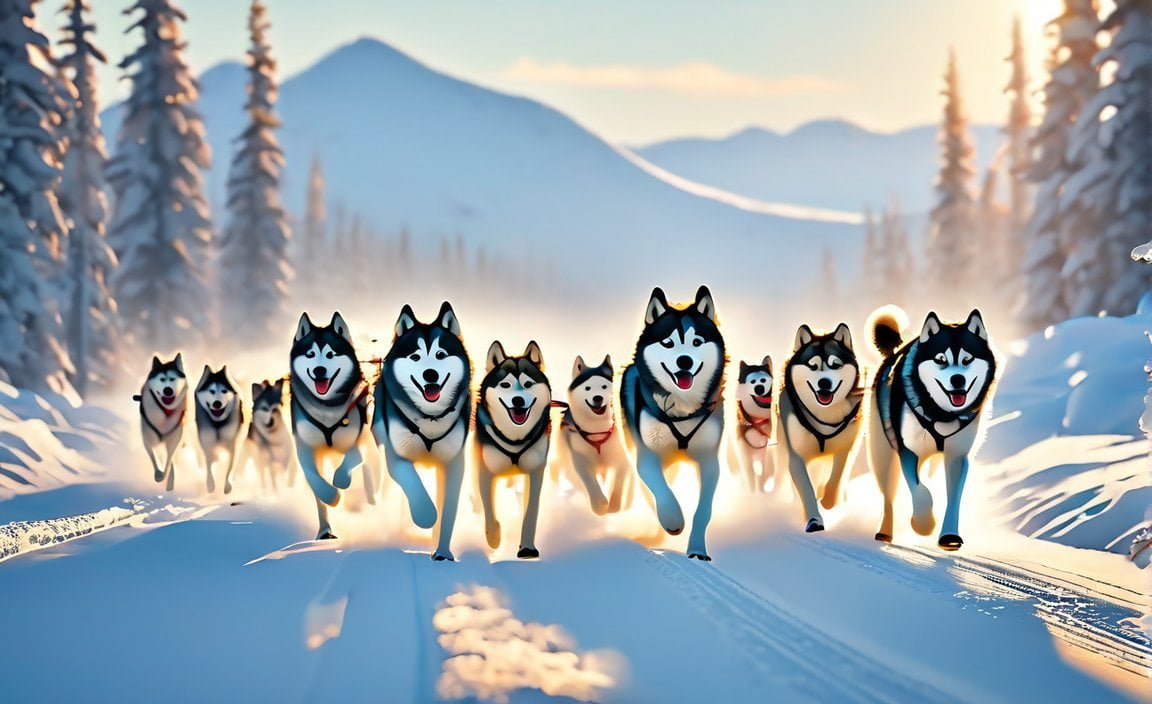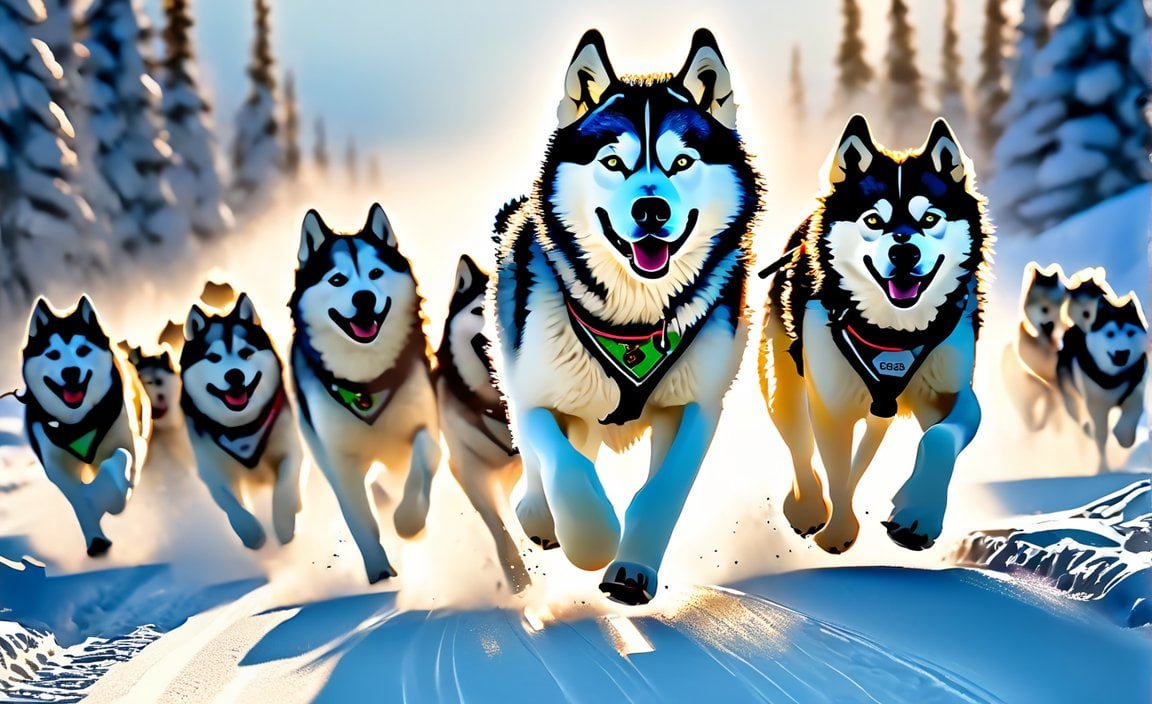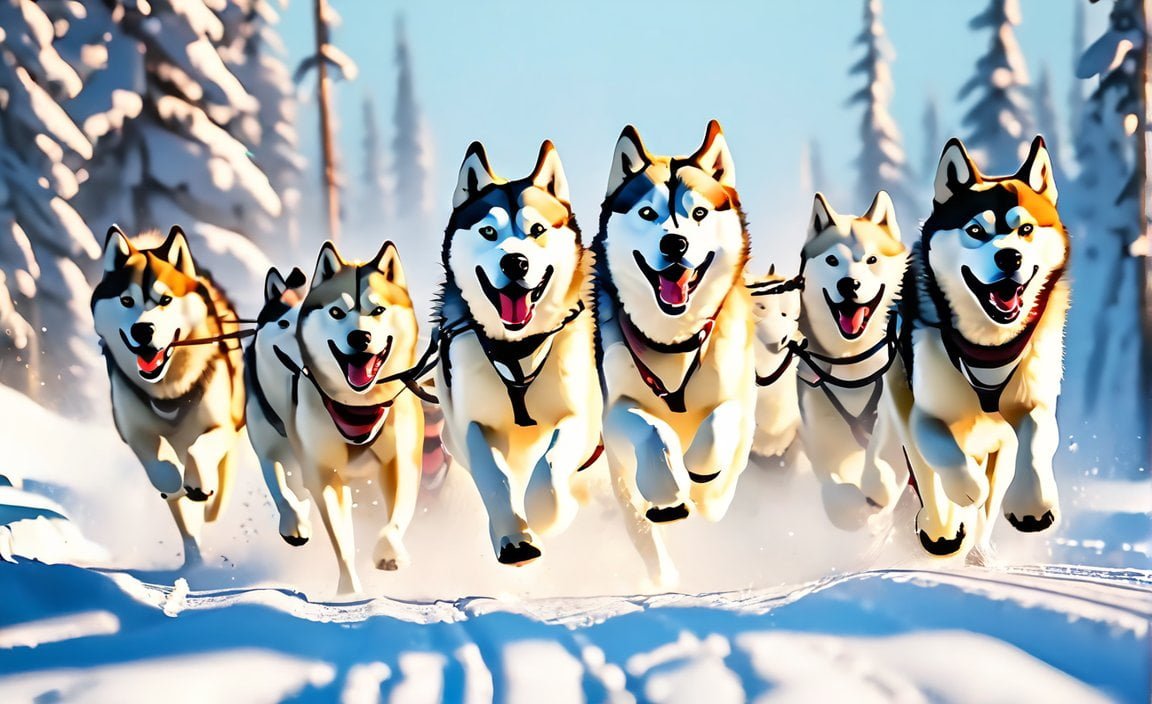Curious to learn more about the exhilarating world of dog sled racing? Look no further! In this article, we’ll dive into 10 fascinating facts about dog sled racing that will take you on a thrilling journey through the sport. From the history of mushing to the challenges faced by mushers, we’ll uncover the thrills and excitement that make dog sled racing an unforgettable adventure. So, grab your sled and join us as we explore the fascinating world of this captivating sport!

Key Takeaways:
- Dog sled racing was originally developed from the Eskimo method of transportation.
- Sled dogs can understand and respond to voice commands.
- Throughout history, humans have partnered with dogs for transportation purposes.
- Sled dog training takes place all year round to ensure their skills are honed.
- The Iditarod, Alaska’s most famous dog sled race, commemorates a lifesaving relay to Nome.
- The biggest threats to sled dogs and mushers are harsh weather conditions and encounters with wild animals.
- Sled dogs require a substantial amount of food to maintain their energy and endurance.
- Dog mushing is Alaska’s official state sport.
- Sled dogs played a significant role in saving Nome, Alaska.
- Alaska hosts an annual dog sled race.
Learn more about dog sled racing:
– britannica.com
– princess.com
10 Facts About Dog Sled Racing
Dog sled racing is an exhilarating sport that combines the awe-inspiring power of a team of dogs with the determination and skill of a musher. As we delve into the world of dog sled racing, let’s uncover some fascinating facts that will shed light on this thrilling adventure.
Fact #1: A Historical Connection
Did you know that dog sledding was developed from a principal Eskimo method of transportation? It’s true! The ancient practice of utilizing sled dogs to navigate the Arctic regions has evolved into the competitive sport we know todaysource. This rich historical connection adds depth and cultural significance to dog sled racing.
Fact #2: A Language of Commands
Sled dogs have an incredible ability to understand and respond to voice commands. These highly trained canines can maneuver through various terrains and obstacles, all while following the instructions of their mushersource. It’s a testament to the strong bond and mutual understanding between musher and dog.
Fact #3: Dogs as Reliable Partners
Throughout history, people have partnered with dogs for transportation needs. From the ancient civilizations to the modern era, our four-legged friends have been trusted allies in traversing vast expanses of land and snow-covered landscapes. The deep-rooted partnership between humans and dogs solidifies their roles in dog sled racing today.
Fact #4: A Year-Round Training Regimen
Sled dog training is a year-round commitment. Mushers dedicate extensive time and effort to ensure their dogs are in peak physical condition. This includes exercises like swimming, hiking, and even pulling weighted sleds to build strength and endurancesource. The perseverance and dedication of both dogs and mushers are truly remarkable.
Fact #5: The Story Behind the Iditarod
The Iditarod, Alaska’s most widely regarded dogsled race, holds a special significance. It commemorates a life-saving relay that took place in 1925, when a diphtheria outbreak threatened the town of Nome. Brave mushers and their trusty sled dog teams delivered vital medicine to the isolated community, and the Iditarod race continues to honor this heroic featsource. It’s a testament to the resilience and valor of the mushers and sled dogs involved.
Fact #6: Nature’s Challenges
Weather and wild animals pose the biggest threats to sled dogs and mushers alike. Harsh conditions, such as blizzards and subzero temperatures, can make the race treacherous. Additionally, encounters with wildlife, like moose or wolves, require vigilance and cautionsource. Overcoming these obstacles demonstrates the sheer determination and skill required in dog sled racing.
Fact #7: Sled Dogs’ Voracious Appetites
Sled dogs have incredibly high metabolisms due to the demands of their sport. They require a substantial amount of high-quality food to maintain their energy levels during races and training. Feeding a team of sled dogs can be quite an undertaking, often involving a diet rich in meat, supplements, and carefully balanced nutritionsource.
Fact #8: An Alaskan State Sport
Dog mushing holds a special place in Alaska’s heart, as it is officially recognized as the state sport. This distinction underscores the immense love and passion Alaskans have for dog sled racing. The sport is deeply intertwined with the state’s history, culture, and natural landscapesource.
Fact #9: Saviors of Nome
In 1925, sled dogs played a pivotal role in saving the town of Nome from a diphtheria outbreak. Mushers and their loyal teams ensured the timely delivery of serum to treat the afflicted, braving treacherous conditions to complete the life-saving missionsource. The heroic efforts of these sled dogs cemented their place in history and further emphasized their invaluable contributions.
Fact #10: An Annual Celebration
Dog sled racing enthusiasts can rejoice, as Alaska hosts an annual dog sled race that captivates audiences from around the world. This thrilling event showcases the skill, speed, and endurance of both mushers and their remarkable canine companions. It’s an unforgettable celebration of the sport and a testament to the enduring legacy of dog sled racing.
The world of dog sled racing is a tapestry woven with history, bravery, and a remarkable bond between humans and their loyal sled dogs. As these 10 facts illuminate the sport’s intricacies, the allure of dog sled racing becomes even more apparent. So, immerse yourself in the exhilarating world of dog sled racing and witness the incredible feats that unfold on the icy trails of adventure.
Learn more about dog sled racing:
– britannica.com
– princess.com
Here are some fascinating facts about animal shelters.
10 facts about animal shelters: Did you know that animal shelters provide temporary homes to millions of pets every year? Click here to discover some interesting facts about these essential establishments.
10 facts about animal welfare: Animal welfare plays a crucial role in ensuring the well-being of animals. Explore these ten enlightening facts about animal welfare and learn why it matters.
10 facts about animal welfare council: Ever wondered what an animal welfare council does? Uncover ten intriguing facts about these organizations and the valuable work they do for animal welfare.
10 facts about animals in Hindi: जानवरों के बारे में हिंदी में दस रोचक तथ्य जानने के लिए यहाँ क्लिक करें। (Click here to discover ten interesting facts about animals in Hindi).
10 facts about being a vet: Are you considering a career as a veterinarian? Find out some intriguing facts about being a vet that will make you even more passionate about this fulfilling profession.
10 facts about being a veterinarian: Being a veterinarian is rewarding but requires dedication. Delve into these ten facts about being a veterinarian and get inspired by the incredible work they do for our furry friends.
10 facts about box turtles: Did you know that box turtles are fascinating creatures with unique characteristics? Click here to discover ten captivating facts about these slow-moving reptiles.
10 facts about dogs and cats: Curious to learn interesting facts about our beloved canine and feline companions? Explore these ten intriguing facts about dogs and cats and deepen your understanding of their behavior and needs.
The Iditarod is the most famous and challenging dog sled race in the world.
The Iditarod Trail Sled Dog Race, known as the “last great race on Earth,” is a thrilling annual event that tests the endurance and resilience of both mushers and their teams of dogs. Spanning a formidable distance of 938 miles (1,510 km) from Anchorage to Nome in Alaska, the Iditarod has become synonymous with adventure and has captivated audiences worldwide. Let’s dive into 10 fascinating facts about this iconic dog sled race.
1. A Historic Journey Through Unforgiving Terrain
The Iditarod takes participants through a diverse and challenging landscape. Mushers and their teams of dogs face treacherous obstacles such as mountains, frozen rivers, thick forests, and desolate tundras. The demanding terrain adds an extra layer of excitement and difficulty to the race.
2. A Test of Endurance
Covering the distance from Anchorage to Nome can take anywhere from 8 to 15 days or even longer, depending on various factors such as weather conditions and the musher’s strategy. The Iditarod is a true test of endurance, pushing participants and their dogs to their limits.
3. A Star-Studded Lineup
The race attracts over 100 participants, with both male and female mushers competing together. Notable names in the Iditarod’s history include Susan H. Butcher, Lance Mackey, and Dallas Seavey, who have left an indelible mark on the sport with their exceptional skills and multiple victories.
4. A Cultural Celebration
In Alaska, the Iditarod is more than just a race; it is deeply ingrained in the state’s culture. Alaskans celebrate the event with great enthusiasm, showcasing their pride in the endurance and courage displayed by the mushers and their dogs.
5. Challenges from Weather and Wildlife
The Iditarod is no easy feat, mainly due to the unpredictable Alaskan weather. Participants must brave harsh conditions like blizzards, extreme cold, and limited visibility. Additionally, the race also poses challenges from encounters with wild animals such as moose or wolves along the trail.
6. The Iditarod’s Historical Significance
The Iditarod race holds historical and cultural significance, commemorating the life-saving relay that took place in 1925 when a diphtheria outbreak threatened the town of Nome. Sled dogs played a pivotal role in delivering life-saving serum over the treacherous terrain, earning them well-deserved admiration.
7. Animal Rights Concerns
Despite its popularity, the Iditarod has faced criticism from animal rights organizations such as PETA (People for the Ethical Treatment of Animals). These organizations raise concerns about the safety and welfare of the dogs involved in the race, sparking ongoing debates about sled dog racing.
8. Economic Challenges and Declining Participation
In recent years, the Iditarod has faced economic challenges, including a decline in sponsorship and declining participation. These challenges have raised concerns about the future sustainability of the race and its impact on the local communities that rely on its success.
9. The Thrill of Dog Sled Racing
Dog sled racing combines the excitement of speed, teamwork, and the bond between mushers and their dogs. The thrill of gliding across snow-covered landscapes, guided by a skilled musher and the synchronized efforts of a well-trained dog team, is a sight to behold.
10. An Iconic Racing Event
The Iditarod’s reputation as the most famous and challenging dog sled race in the world has made it a symbol of adventure and determination. The race embodies the essence of the Alaskan wilderness and the enduring spirit of human and canine athletes.
Key Takeaways:
- The Iditarod Trail Sled Dog Race covers a distance of 938 miles (1,510 km) from Anchorage to Nome in Alaska.
- The race is a test of endurance, taking participants 8-15 days or more to complete.
- Over 100 participants, including both male and female mushers, compete in the event.
- The Iditarod holds historical and cultural significance, commemorating a life-saving relay in 1925.
- The race faces criticism from animal rights organizations, raising concerns about the welfare of the dogs involved.
- Economic challenges and declining participation have raised concerns about the future of the Iditarod.
- The race’s challenging terrain and unpredictable weather add to its allure and difficulty.
- Notable mushers such as Susan H. Butcher, Lance Mackey, and Dallas Seavey have made their mark in the Iditarod’s history.
- The race is celebrated as a significant part of Alaska’s culture and showcases the endurance and resilience of mushers and their dogs.
- Dog sled racing combines speed, teamwork, and the bond between mushers and their dogs, creating an exhilarating experience.
Sources:
– Iditarod Trail Sled Dog Race | History, Map, & Facts | Britannica
– Iditarod Trail Sled Dog Race – Wikipedia
Dog Sled Racing Requires Careful Planning and Strategy
Key Takeaways:
– Competitive dog sledding involves strategic planning, navigation skills, and critical decision-making during races.
– Long-distance dog sled races expose participants to various health challenges and require careful management.
– Sled dog races can be categorized based on distance, from sprints to long-distance races like the Iditarod.
– The Iditarod Sled Dog Race in Alaska covers approximately 1,600 km and is renowned in the sport.
– Marathon sled dog races often lead to orthopedic injuries and pose significant physical and mental challenges.
– Dog sled racing takes place in a variety of locations, including snow-covered terrain and even warmer climates.
– Endurance sled dogs have high energy requirements, especially during winter training.
Dog sled racing is an exhilarating sport that demands careful planning and strategy. Every musher knows that success in a race depends on more than just the speed of their dogs. Let’s explore some key factors that make dog sled racing a thrilling and strategic endeavor.
1. Strategic Planning and Navigation
Dog sled racing requires meticulous strategic planning. Mushers must study maps, understand weather patterns, and make critical decisions during races. Every turn, every hill, and every obstacle must be carefully evaluated. The ability to navigate through varying terrain and unpredictable weather conditions is crucial for success.
2. Exposure to Health Challenges
Long-distance dog sled races, such as the renowned Iditarod in Alaska and Finnmarksløpet in Norway, push mushers, handlers, and dogs to their limits. These demanding races expose participants to various health challenges, with marathon sled dog races often leading to orthopedic injuries. Fatigue, extreme cold, and prolonged physical exertion can take a toll on both the mushers and their dogs.
3. Categorization of Sled Dog Races
Sled dog races can be categorized into different distances. Sprint races cover 4 to 100 miles, mid-distance races range from 100 to 300 miles, and long-distance races surpass 1,000 miles. The famous Iditarod Sled Dog Race is a prime example of a long-distance race that crosses approximately 1,600 km from Anchorage to Nome.
4. The Challenge of the Iditarod
The Iditarod Sled Dog Race in Alaska is a well-known event in the dog sledding community. It challenges mushers and their teams to endure a grueling 1,600 km journey through harsh Alaskan terrain. The race takes approximately 8-15 days to complete, or even longer in challenging conditions. It requires careful planning, navigation skills, and strategic decision-making.
5. Physical and Mental Challenges
Dog sled racing is not only physically demanding but also mentally challenging. Mushers and handlers participating in marathon races face significant physical and mental obstacles. The endurance required to endure long hours on the trail, withstand extreme weather conditions, and manage a team of energetic dogs is immense.
6. Diverse Locations for Dog Sled Racing
While dog sled racing traditionally takes place in snow-covered terrains, the sport has expanded to include various locations worldwide. Some races are held in regions with warmer climates, where wheeled carts replace sleds. This diversity adds a unique twist to the sport and allows for a broader range of participation.
7. High Energy Requirements for Sled Dogs
Endurance sled dogs, including Inuit sled dogs, have high energy requirements. During winter training, their daily energy needs can reach approximately 16,730 kJ (12,000 kcals). A carefully balanced diet is necessary to ensure the dogs maintain their strength and stamina throughout the race season.
In conclusion, dog sled racing is a thrilling sport that requires meticulous planning and strategic thinking. Mushers must navigate through challenging terrains, make critical decisions, and manage the well-being of their dogs. Whether participating in a sprint or a long-distance race, careful planning and strategy are instrumental in achieving success in this exhilarating sport.
Sources:
– Facts.net
– Directory of Open Access Journals
Dog sled racing promotes a strong bond between mushers and their dogs.
Dog sled racing is not just a thrilling sport; it’s also an avenue for mushers to develop a remarkable connection with their dogs. This bond is nurtured through trust, understanding, and a shared love for the adventure. Let’s explore 10 fascinating facts about how dog sled racing promotes a strong bond between mushers and their dogs.
1. The Language of Trust and Understanding
Dog sled racing cultivates a unique bond between mushers and their dogs, rooted in the understanding of body language. Mushers rely on subtle cues and gestures to communicate with their team of dogs, forming a silent language built on trust.
2. Beyond Commands and Control
Mushing is more than just issuing commands or steering the sled. It involves building an emotional connection with the dogs. Mushers spend countless hours working closely with their team, forging a deep bond that goes well beyond the racing season.
3. The Winter Wonderland Sport
Sled dog racing is a captivating winter sport, predominantly popular in Arctic regions. It involves teams of highly trained sled dogs pulling a sled with the musher standing on the runners. The breathtaking snowy landscapes and the harmonious coordination between mushers and dogs make this sport truly mesmerizing.
4. A History Steeped in Adventure
Dog sledding has a rich history that dates back to at least 6000 BC. This sport has been practiced in various parts of the world, with its origins deeply rooted in the Eskimo method of transportation. Through the centuries, dog sledding has evolved into a thrilling sport, combining speed, endurance, and a profound connection between musher and dogs.
5. The Iditarod Trail Sled Dog Race: A Legendary Journey
The pinnacle of dog sled racing is the renowned Iditarod Trail Sled Dog Race. This grueling race covers nearly 1,000 miles through the stunning Alaskan wilderness. Mushers and their dogs face extreme weather conditions, treacherous terrain, and a test of endurance, showcasing the unwavering bond they share.
6. Fueling the Expedition
Endurance sled dogs have specific dietary energy requirements to sustain their long-distance races. Proper nutrition is crucial in providing the dogs with the energy they need to perform at their best. Mushers work closely with nutritionists to ensure their team receives the optimal diet for their unique needs.
7. A Partnership of Trust and Connection
Dog sled racing requires mushers to place their unwavering trust in their canine teammates. The shared experiences, triumphs, and challenges strengthen the bond and deepen the connection between mushers and their dogs. It’s a partnership built on mutual respect and a united desire to conquer the race.
8. Ethical Considerations
While dog sled racing celebrates the bond between mushers and their dogs, it also raises ethical questions. Critics express concerns regarding the treatment and overall well-being of the dogs involved. Responsible mushers prioritize the care, health, and happiness of their dogs, ensuring their welfare is paramount.
9. A Journey of Adventure and Determination
Participating in dog sled racing requires immense determination, physical strength, and mental fortitude. Mushers navigate through challenging terrains, face unpredictable weather conditions, and encounter wild animals along the way. This journey embodies the spirit of adventure and showcases the unbreakable bond between mushers and their dogs.
10. Building a Team, Achieving Greatness
In dog sled racing, mushers and their dogs work as a team, harnessing individual strengths and abilities to achieve greatness. The bond between mushers and their dogs extends beyond the race, creating a lifelong connection that is cherished by both.
Key Takeaways:
- Dog sled racing fosters a strong bond between mushers and their dogs, based on trust and understanding of body language.
- The sport goes beyond commands and control, requiring a deep emotional connection.
- The Iditarod Trail Sled Dog Race is a legendary journey that tests the bond between mushers and dogs in extreme conditions.
- Proper nutrition is essential to fuel the dogs’ endurance and performance.
- Responsible mushers prioritize the well-being and care of their dogs, addressing ethical considerations.
- Participating in dog sled racing embodies determination, adventure, and teamwork.
- The sport of dog sled racing has a rich history dating back to ancient times, showcasing the enduring bond between humans and dogs.
Sources:
– Facts.net
– Britannica

FAQ
Q1: How did dog sledding originate as a method of transportation?
A1: Dog sledding originated from an Eskimo method of transportation and has been used throughout history by people partnering with dogs for transportation.
Q2: What are the biggest threats to sled dogs and mushers during races?
A2: The biggest threats to sled dogs and mushers during races are weather conditions and encounters with wild animals.
Q3: How much food do sled dogs require?
A3: Sled dogs require a significant amount of food due to their high energy needs for training and racing.
Q4: Is dog mushing the state sport of Alaska?
A4: Yes, dog mushing is the state sport of Alaska.
Q5: What is the significance of the Iditarod race in Alaska?
A5: The Iditarod is a famous dogsled race in Alaska that commemorates a lifesaving relay and is considered the “last great race on Earth.”
















